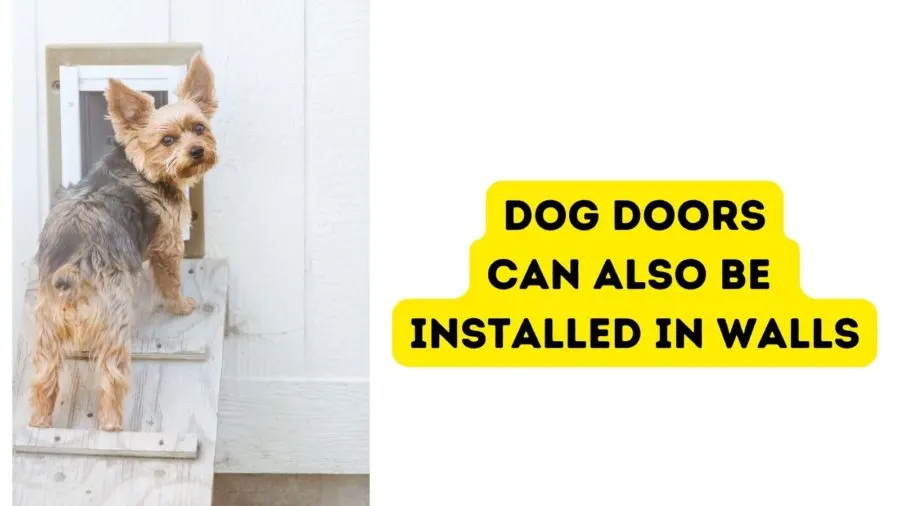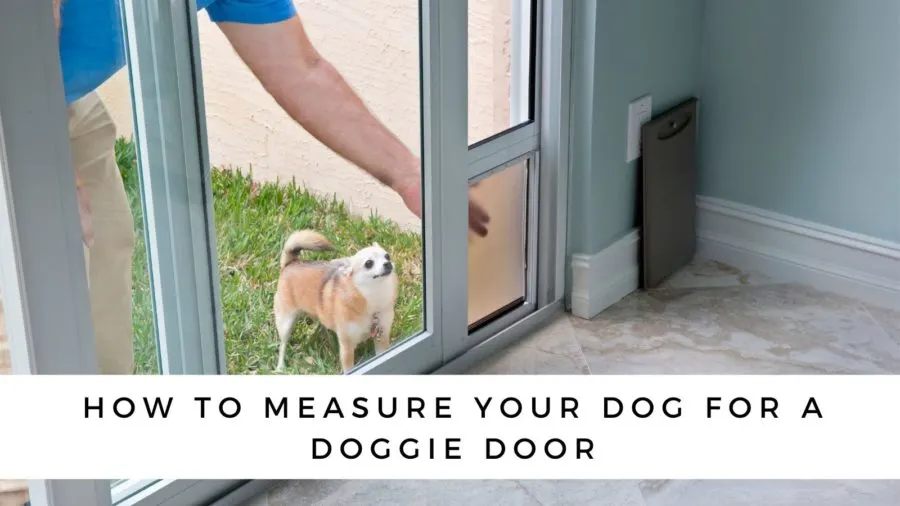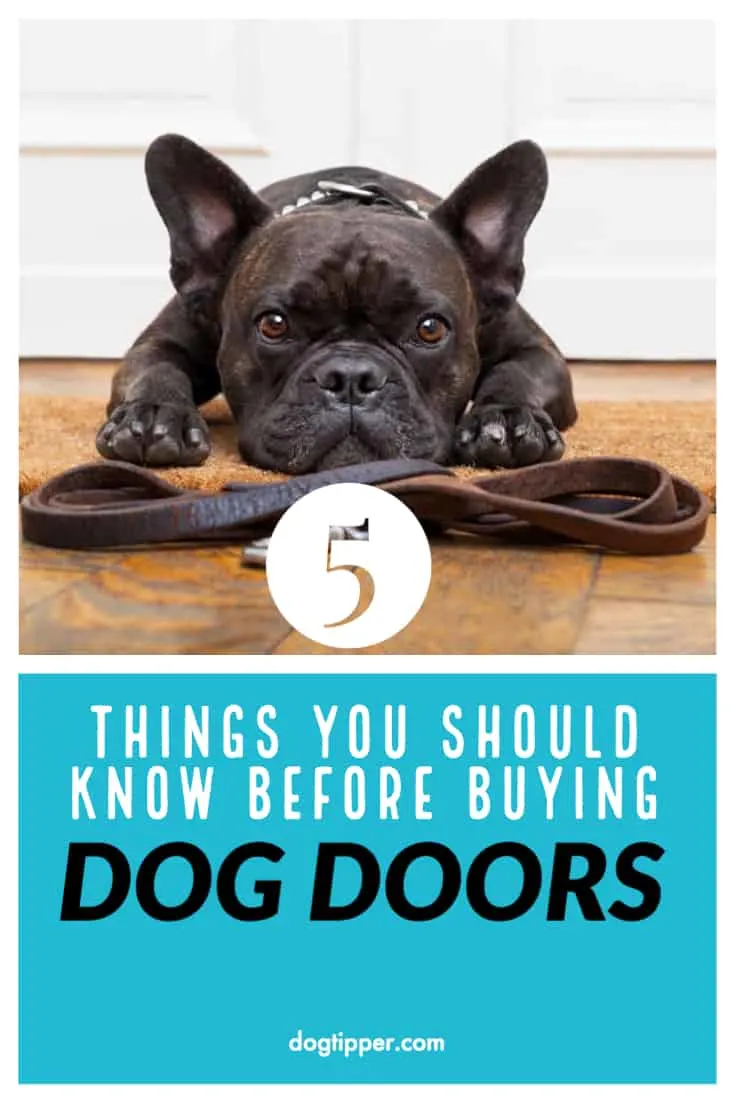Whether you’re just tired of playing doggy doorman or you need a way for your dogs to get outside to potty while you’re at work, you may be looking for a way for your dog to come and go from the house on his own. The answer just might be a dog door, one that can be installed either permanently or, if you’re renting, temporarily to give your dog access to your yard while you’re away. Before you start shopping, though, we’ve got five things you should know before buying a dog door.
Are Doggie Doors a Good Idea?
Before you start deciding what type of dog door you need, consider first the question of are doggie doors a good idea? The answer: that depends.
Whether or not you should install a dog door depends on:
- your dog
- other pets in your home
- your yard
- your schedule
When you are away at work, is your dog home alone? Does he usually go out in the yard to potty, rather than using pee pads? If so, a doggie door might be a good solution.
Do you share your home with indoor-only cats as well as your dog? In this case, a doggie door might NOT be a good answer. There are high-tech doggie doors (see below) which can read your dog’s microchip and let HIM out while keeping your cats indoors, if you trust that option.
Is your yard protected from snakes and coyotes? If you feel comfortable with your dog going out in the yard unsupervised, a doggie door might be a good option.
If you are concerned about a run-in with a coyote (or even a hawk, if you have a small dog), a doggie door might not be the best choice.
Doggie Door Installers: Will You Need One?
Before you start looking at the types of dog doors, also consider the extra expense of doggie door installers.
While some dog doors–such as those in sliding glass doors–can be installed by homeowners, others require a professional to cut into a door or even a wall for installation.
You may be able to find good installation videos online if you are handy with tools; otherwise, plan on the cost of installation along with the cost of the doggie door when you are considering this addition to your home.
5 Things You Need to Know Before Buying a Doggie Door

Dog doors have gone high tech.
The days of the simple flap are gone; today you can shop for a dog door that reads your dog’s microchip and opens specifically for him.
Not only will this keep visiting dogs out of your house, but it will also prevent wildlife from entering your home–or, if your dog door is extra-large, will prevent a burglar from entering.
If you have multiple pets, you can restrict access to keep cats indoors while your dog comes and goes–or restrict one dog recovering from surgery or an injury while the other dog still uses the door.
You may need to train your dog to use a doggy door.
Some dogs take to the concept of the dog door faster than others. You may need to train your dog to use the door door.
As with any training, take it slowly and make it fun for your dog!
Get a friend to join you in the training and, with one of you on each side of the doggy door, use a favorite treat to train your dog, first working through just the opening of the dog door, with the flap removed.
Take the training step by step, letting your dog proceed at his own pace, watching for signs of stress before you advance to the next training step.
After your dog is comfortable going back and forth through the dog door opening, you’ll add the flap.
A smear of peanut butter on the flap will encourage your dog to get his face right up to the flap, a vital step toward opening the flap on his own.
Dog doors aren’t just for doors any more.
When you consider buying a dog door, the first type that probably comes to mind is the dog flap installed permanently in an exterior door. That’s definitely the most popular option but it’s not your only choice.

Homeowners can opt for wall-mounted dog doors, literally cutting a hole in the exterior wall to give your dog access to the lawn.
Plan on professional installation of the doggy door or dog flap somewhere in the $100-$200 range for the flap type of door.
For DIYers and renters, sliding patio doors can be fitted with dog doors. The new doggy door fits into the track and secures to the frame but, when you move, you can easily take the dog door with you.
Size matters.
Dog doors range from small to extra-large with a size for every canine.
But don’t just consider your dog at the moment when deciding on the size. If your dog is young, is he still growing?
What if you later adopt another dog–would you get a dog the same size or smaller?
Let’s face it: a dog door is a fairly large purchase, especially when you factor in installation costs.
If you think you might later add a larger dog to your family, it’s safer to go up in size; a smaller dog can easily use a larger dog door but it doesn’t work the other way around!
While upsizing has its perks, consider the weight of the flap if you have a very small dog; some flaps have magnetic snaps that help with your home’s energy efficiency but can make the flap more difficult for smaller dogs to open.
The downside of upsizing? Security…our next topic!
Consider home security when making your choice.
If you need a larger dog door, spend extra time comparing security features before you make your selection. Why? Because with the extra size, you need to ensure that ONLY your dog is entering through that doggy door! Yep, there have been instances of burglars entering homes through dog doors!
Electronic dog doors that read your dog’s microchip or special dog tag provide extra security. This microchip dog door then only opens when YOUR dog gets in range.
A doggy door with manual locks let you lock the door any time, including when you’re traveling or sleeping using manual locks on each side.
Tinted flaps are helpful for preventing potential burglars from peeping into your home to check for two- or four-legged residents.
One Dog Mom’s Advice
Lindsay Shugerman is an advocate for dog rescue, and loves fostering pups waiting for home. Lindsay lives in Austin, Texas with her husband, daughter, dog, cat, and various 4-legged guests–and shared her thoughts on choosing the right dog door.
It would be nice if we could always be there for our pets, letting them in when it gets too hot or too cold, letting them out when nature calls or that pesky squirrel is just begging to be chased. But between jobs and kids and activities and everything else we have to do, it’s just not possible.
So we decide to install a pet door to make it easy for Fido or Fluffy to go in and out on their schedule instead of ours. Simple, right? Buy a door, put it in, and presto…instant access.
But wait! It’s not that simple! A quick search of the options at pet supply stores yields dozens of pet doors in all kinds of shapes, sizes and styles. How do you find the right one for your house and your pets?
Choosing a pet door means considering 5 factors:
- pet size
- pet type
- entrance options
- security
- energy efficiency
Taking it step by step through each factor will help you find the best pet door options for your family.
Pet size
Of course your pet has to be able to fit through the door, but that’s not as straightforward as it sounds.
Many people measure their dog or cat from the ground to the top of their head, and then try to find a pet door that size. But if you have a large dog, you might conclude that there are no doors tall enough for your pet. And if you have a smaller dog or a cat, you might end up buying a much larger door than you actually need.

How to Measure Your Dog’s Height for a Doggie Door
To measure your dog for a doggie door, instead of measuring floor to head, measure your pet’s height at his or her shoulder (typically this is the highest part of their back.) Pets will automatically duck their heads and lift up their feet when they go in and out. Consider this the minimum height for your new pet door.
You may need to add a couple of inches if there is a ledge or stoop they need to step over. If you have more than one pet, size the door for the taller animal.
How to Measure Your Dog’s Width for a Doggie Door
Don’t forget to also consider width when measuring for a doggie door. Your dog needs to comfortably fit through from side to side as well. You can estimate this by seeing how wide open a regular door needs to be to allow your pet to walk through without rubbing against the sides. Or you can cut a hole in a cardboard box, place a treat inside and find out what width works for easy access.
Also, consider growth. A puppy, even one approaching a year in age, might grow more. Either allow for the growth or hold off on buying a door until your dog is fully grown.
Pet Type
Although it might seem that any animal of a certain size could fit through the same pet door, different animals have different levels of strength. They also may differ in their willingness to push against a heavier flap, or safely wear an electronic collar to open limited access dog doors.
The ability to jump or climb is also a factor, so pay attention to the height of the window or door frame when making your choice.
Also, older or sick animals might need different door types than younger or healthier ones. Dog or cat doors that require pushing or stepping up and over an obstacle might not work for a pet with physical challenges. And doors that blend into the surrounding door could be almost invisible to pets with eye problems.
Entrance Options
Pet doors can be installed in walls, entry doors, storm doors, garage doors, sliding glass doors and double-hung windows. You can also install a pet door in some other window types, if you’re willing to have custom glass work done.
The choice of where to place the dog door depends on your home’s design and the location of safe, accessible entrances and exits. Some people are hesitant to cut holes in walls and exterior doors. For those shoppers, a door that fits into an existing window or sliding door frame might be the best choice.
Some pet owners who want the convenience of a pet door in an exterior door without destroying resale value of the home have purchased a second, less expensive door to use temporarily. That way, they can cut the door and install a pet entrance, then rehang the fancier door when it’s time to sell. This also works well for renters who cannot destroy the landlord’s door but want pet access.
Security
We’ve all heard about cases where a burglar entered a house through a pet door – it’s a popular theme on television shows as well (especially when the would-be intruder gets stuck!)
Although it’s unlikely that any human could fit through most pet doors, you will probably have a time when you don’t want your cat or dog using the door. And you certainly don’t want the neighborhood raccoons or squirrel showing up in your kitchen!
Travel is another factor. When you go on vacation with your pet, it’s nice to be able to lock the pet door to add a feeling of security. Depending on your family, you also may need to keep your small children or grandchildren from crawling out through a pet door, especially one that opens onto an unfenced area, stairs, a pool, or an upper story exit.
The security level of pet doors ranges from none (a simple flap) to doors with locks, slide-in panels, and even pet doors that work with electronic collars that only allow animals wearing the collar can enter or exit.
Spend some time thinking about the issues you might face with an unsecured pet door, then select the door that offers at least that level of lock or access-restriction. In most cases, too secure is better than not secure enough.
Energy Efficiency
With energy costs through the roof, everyone is concerned about saving money on heating and air conditioning costs. An inefficiently designed or incorrectly installed pet door can take a chunk out of your energy budget. But a properly installed door can actually save you money over opening and closing a regular door multiple times a day.
There are several options in pet door design that can minimize heating or cooling loss. The first factor is to select the right door for your space. “Making-do” with a door that’s too small, and trying to fill in the gaps with wood, plastic or even towels is an almost guaranteed energy-loss.
A second factor is door placement. Try to place your pet door away from areas that get regular high winds or extreme sun exposure.
The other common mistake in installing dog doors is skipping the weather-stripping. Most doors come with weather stripping. If not, make sure you buy weather stripping and install it according to manufacturer’s directions. If you’re installing the door into a wall, caulking around the opening on both front and back will minimize air leaks. Use a clear silicone caulk unless the door manufacturer
recommends something else.
There are pet doors designed to further reduce energy loss. Doors with double flaps, magnetic flaps and self-sealing edges will help to keep air loss to a minimum. A door that offers a locking panel or other means of security when you’re not using it will further cut waste.
Take Your Time
A pet door is seldom an emergency purchase, so take your time and consider all the factors. With some planning and shopping, you’re sure to find the perfect door for you and your pet.
Dog doors can be a great way to give your dog the freedom to go outside to potty while you’re away, especially important as dogs get older. Spend some time comparing the growing number of models on the market to make sure your dog door is a good fit for years to come.
Pin it to remember 5 things to know before you buy a doggy door!

- Review: Jimmy BX7 Pro Anti-Mite Vacuum Cleaner - December 16, 2024
- 🎉 GIVEAWAY: Lord of the Pets Portrait of Your Dog! - November 26, 2024
- Review: Lord of the Pets Portraits - November 17, 2024
